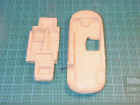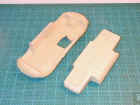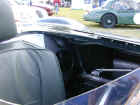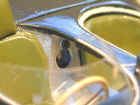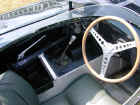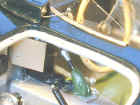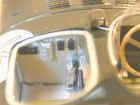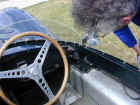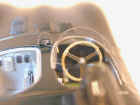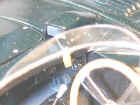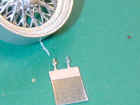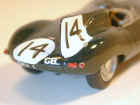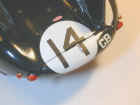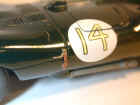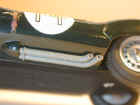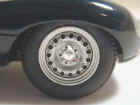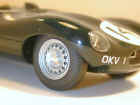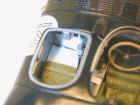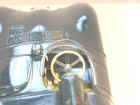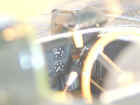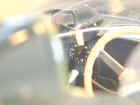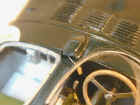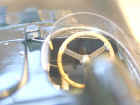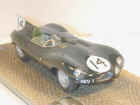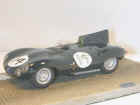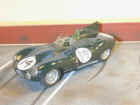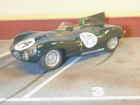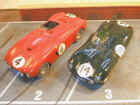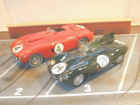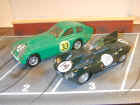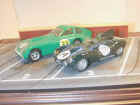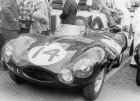|
|||||||||||||
|
For several years quite a few of you have asked whether I would consider re-making some of the earlier MPH subjects, in particular C and D types (built between 1987-90), to today's standard and specification. I have always resisted this request, as I felt it was unfair to the customers who bought the original model of a particular car. However, an opportunity has now presented itself. Perhaps the best known D type of all, OKV.1, came into the ownership of Peter Neumark, who suggested I might like to do a model of it. He has very kindly given me unlimited access to this wonderful machine, from the moment it was disinterred from the National Motor Museum at Beaulieu and arrived in its somewhat butchered state, to be rebuilt in Shropshire, most conveniently for me!
Read about the Jaguar D type story > Here The MPH model Amazingly, and to their very great credit, they managed this "impossibility" with all the very difficult undercuts and details, and I am most grateful to them.
Major works include making a removable tonneau cover, for the first time, revealing a lot of interesting detail added to the bulkhead in front of the passenger's knees, the re-worked transmission tunnel, handbrake and fire extinguisher. Making the base much narrower (see paragraph above) created another problem, in that the floor join between body and base would have been visible and unrealistic. The solution was to make separate floors, photo-etched and hand-shaped to follow the curve of the monocoque.
Smaller satisfying details have included all visible cockpit wiring, control wire to mirror, fuel filter, peeking through the rear cockpit bulkhead, and hand-shaped bonnet and boot catch handles, from the ubiquitous nickel silver rod. The third set of wheels ended up being bespokedly turned in aluminium, replacing the two previous attempts which did not satisfy, due to rim and offset inaccuracies. Insert detail for these were provided by Renaissance in France, who photo-etched and then pressed the contours into them, lovely! Note also "Dunlop" decals. Comparing with the actual car
Editor Note The prototype d type "OVC501" was at the Goodwood Festival of Speed in 2000 and this very original car provided much of the information to create the model. There are some differences but in the main "OKV.1" was very similar to the prototype when it arrived at Le Mans in 1954. I have included several pictures taken at Goodwood. I have several of Tim's creations in my collection and one of the pleasures of ownership is to go through the list of features when it arrives. In some cases I have built the kit which was used as a base and it is just slightly "mind blowing" to compare the before and after. Some of his techniques have been included in my own humble attempts at model making and what is always fascinating is how many of the mods you can not even see! They may be buried away in the footwell but believe me they are there! This little gem costs a mere £375.00 pounds, of course it would be no use if you could not drive it away so in the box you will find a piece of photo etch fret with two spare ignition keys in case the one hanging on the bottom of the dash just to the left of the rev counter gets lost! Yes he is completely and utterly stark staring mad! Below is the list of all the tasks involved in creating the model you see in the pictures. The pictures show a mixture of "OVC 501" and the model. The unfinished resin parts are an Automany kit with one sill on the chassis and the other on the body.
"The special features of the model"
MPH specification, Jaguar D type - Le Mans 1954 > Here
Jaguar's learning curve at Le Mans was certainly on the fast track. A "toe-in-the-water" foray with three privately owned and virtually standard XK 120's in 1950, where one of the cars held 2nd place for a long time, led the factory to think of what might be achieved with a car built specifically for racing. A mere year later, in 1951, this project came to fruition in a way that could not have been bettered, with the XK 120 C (as it was then called) winning first time "out of the box", the Peters Walker and Whitehead in the cockpit, at a record average of 93.5 mph. 1952 saw a rare mistake in tactics and preparation. Stirling Moss, driving a C type in the Mille Miglia of that year, prior to Le Mans, reported that the 300 SL Mercedes-Benz, the Jaguar's most likely rival at Le Mans, was showing a turn of speed superior to the C type. Unlike the usual methodical development typical of the Coventry marque, radically and hastily re-shaped nose and tail sections were rushed out for the 24 hour race, without adequate testing. Sadly the long nose configuration proved inadequate in its ingestion of air, and the inevitable overheating sidelined all three team cars within a couple of hours. Their lesson learned, the team returned triumphantly in 1953 with the bodywork restored to near 1951 shape, setting another new record average of 105.9 mph, Tony Rolt and Duncan Hamilton doing the pedalling.
Anxious to maintain its superiority at Le Mans, Jaguar went to great lengths to keep the development of its replacement for the C type away from prying eyes. It is an interesting comment on the way the press operated then, as compared to now, that a high speed test at Jabbeke in October 1953 went unreported, as did tests at RAF Gaydon, Reims and Le Mans itself, during an international rally where the circuit was closed for the purpose. Aerodynamicist Malcolm Sayer, who designed the radical new bodywork for the car, took inspiration from the Alfa Romeo "Disco Volante" built in 1952, and the first prototype (referred to as XK120 C MKII) looked remarkably like the Alfa. As it developed, its origins became less obvious, but the wonderfully "swoopy" shape remained.
The factory press release, as late as 5th May 1954, referred to the new (unnamed) car as having body and chassis built as one unit (later to be referred to as "semi-monocoque") with monocoque cockpit section attached to tubular chassis to bear engine and suspension, etc. Other information in that press release showed that the car was smaller than its predecessor in all dimensions except width. One can easily forget how small the D type (as we now know it) is. Whilst making this model I had 1/43rd scale body shells for a D type and a modern day Lotus Elise (which one thinks of as a very small car) on my bench at the same time. The dimensions are, correctly, virtually the same - but the Elise is wider! The works took four of the new cars, now known as XK120C MK IV's, to Le Mans, the prototype, which did not run, and three brand new ones, for Rolt/Hamilton (OKV.1), Moss/Walker (OKV.2) and Whitehead/Wharton (OKV.3). In practice Walker set the fastest time. All went smoothly with the other team cars as well, and confidence was high.
Race day dawned with a forecast of rain, which duly arrived in different intensities at various times during the 24 hours, from drizzle to monsoon conditions. At flag fall the team of three 4.9 litre Ferraris rushed off into the lead, stalked by the Jaguars of Moss, Rolt and debutant Wharton who had already picked up some bodywork damage on the first lap. After one hour the Jaguars lay 3rd, 4th and 11th, with the prancing horse team still in 1st and 2nd places. In torrential rain, towards the end of the second hour, Moss briefly took the lead, but was back in 3rd behind the two Ferraris at the end of the hour. At this stage misfiring problems started to hit the Jaguar team. At first plugs were changed in an effort to solve the problem. This didn't work, and eventually the diagnosis turned out to be dirty fuel, with which the filters could not cope. Precious time was lost identifying and then solving this problem by removing the filters. In the case of OKV.1 removal of the filter took an astonishing 8 minutes 47 seconds, which could well be said to be the defining point of the race. At the 4 hour mark, Whitehead/Wharton in OKV.3, less affected than the other team cars by the fuel problem, were steady in 4th place with Rolt/Hamilton catching up in 5th, and Moss/Walker trailing back in 27th place, Walker having to stop out of the circuit, to remove his filter, and taking no less than 33 minutes to complete a lap! At midnight Moss was out, suffering a catastrophic brake failure at 160 mph at the end of the Mulsanne straight. The escape road was open, as always, but unfortunately populated by two rather sleepy gendarmes having a quiet smoke! Somehow he avoided them and limped round to the pits to retire.
Eventually the Whitehead/Wharton car succumbed to fuel and other problems and retired in the early hours, having been as high as 2nd earlier. Meanwhile Rolt and Hamilton, fighting their way through the rain, inherited 2nd place from the retiring Ferrari of Rosier/Manzon just after dawn, albeit two laps down on the leading Ferrari of Gonzales/Trintignant. Hamilton, acknowledged to be one of, if not the fastest wet weather pilots, was catching up during the downpours, with Gonzales fighting back in the drier periods. Later, Rolt, in avoiding an errant Talbot, visited the sandbank at Arnage, losing two precious minutes at the pits knocking out the damage. By midday Hamilton and Gonzales were matching each other's times, but Rolt was able to carve vital seconds from Trintignant. At the final Ferrari pitstop, with less than two hours, to go, more drama! The red car wouldn't start, as six precious minutes of their time was lost, before it started, attended by a wholly illegal team of mechanics. Jaguar could have protested, but to their great credit, didn't (imagine that today!). Then Rolt came in, seeking to change his goggles for a vizor in the atrocious conditions. Instead he was sent out for another lap whilst Hamilton, reckoned to be faster in the wet, was kitted up. Next lap, and for the remainder of the race, it was Hamilton slithering about the skating rink doing his utmost to close that tantalising gap. He failed, gloriously, and Jaguar lost by a mere 105 secs, not bad for a first outing.
After Le Mans OKV.1 was sold to Duncan Hamilton, who raced it extensively in 1955, converted into an XK SS type road car, then sold it to "Jumbo" Goddard, who also used it as a road car before exporting it to Australia in 1965, where it was again used on the road and for occasional mild competition work. After Goddard's death, it was purchased at auction in 1984 by Robin Davidson, who housed it at the national motor museum at Beaulieu. After sixteen years of inactivity it was purchased by Peter Neumark and completely rebuilt to its Le Mans specification by his restoration company, C.M.C. in Bridgnorth, Shropshire, a locality most convenient for this scribe, who was privileged to be invited to see OKV.1 as rescued from its enforced inactivity, during its rebuild, and as completed at the Le Mans legends race in June 2001.
|

